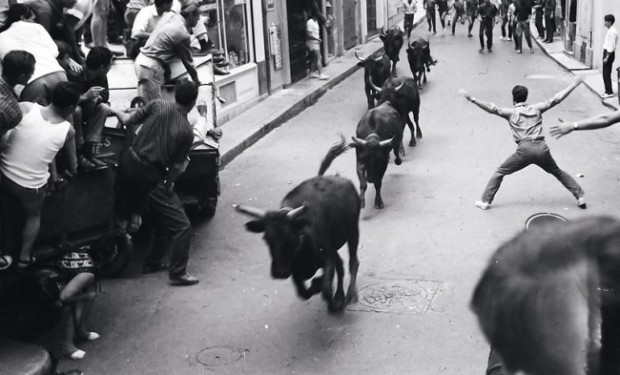The bulls are stampeding from Spain to the U.S., and you can join them . . . if you just sign and waive this, this, and this (oh, and that too)
The “Running of the Bulls” is making its way to the United States, but safety and liability issues cause major concerns.
Would you be willing to sign a waiver agreeing to the possibility of being “trampled, gored, rammed or tossed in the air by a bull?” It may sound crazy, but thousands of people signed up to participate in the United States’ newest version of Spain’s popular “Running of the Bulls,” which began on August 24, 2013, in Richmond, Virginia.
Rob Dickens and his business partner, Brad Scudder, both of whom previously practiced law, created the event. When the day-to-day practice of law became mundane for the duo, they decided to build intense obstacle courses, such as Rugged Maniac, a five-kilometer trek, not designed for the faint of heart. These obstacle courses still were not thrilling enough for Dickens and Scudder, so they decided to bring the adrenaline pumping “sport” of running with the bulls to the United States. The event was open to the public, but participants had to be willing to sign a detailed waiver, ultimately limiting their right to sue the organization if injuries were sustained.
The waiver does not prevent participants from suing, but it does prevent them from winning.
Running with bulls is unbelievably dangerous, but who better to draft a waiver and avoid lawsuits than two former attorneys? The waiver warns participants of the possibility of broken bones, deep lacerations, paralysis, and even death, among a number of other injuries. It does not prevent participants from suing, “but it does prevent them from winning,” says Dickens.
“The Great Bull Run” prides itself in taking more safety precautions than its sister race in Spain, but the event’s website makes it clear that running with these animals is still in no way “safe.” Participants are accepting the risk of getting seriously injured, but according to the site, that is what makes it so thrilling.
In order to make the event safer, the creators made sure that each run would be on grass or dirt, not city streets. This change helped to improve traction and ensured that fewer people would fall and risk the chance of being trampled. There are also no sharp turns that the participants or the bulls were required to take. In Spain, these turns often pose the most difficulty for the runners and the bulls because it is extremely challenging for the animals to make sudden turns, leading to pile-ups of both bulls and people.
There are also easy escapes for runners who wish to get out of harm’s way. Cattle fencing allowed participants to exit the track easily, and nooks were built in to the course so that runners could quickly avoid being trampled. The website also claims that the events would not use “hyper-aggressive fighting bulls that have been trained to seek out and gore humans on sight, nor will we be filing the bulls’ horns to razor-sharp points.”
Even with all of these safety measures put in place, running with bulls remains a dangerous activity.
Running with wild animals is a huge risk in and of itself, but adding loud music and alcohol creates a recipe for disaster.
Virginia’s event – the first of many across the United States – featured four runs, each involving fifteen rodeo bulls and nine steer charging around a dirt track at Virginia Motorsports Park. To add to the chaos, there were live bands, a tomato fight (also modeled after one of Spain’s famous traditions), and in keeping with the spirit of the original event, there was the celebratory drinking of alcohol. Running with wild animals is a huge risk in and of itself, but adding loud music and alcohol creates a recipe for disaster.
Even with a safer course and more controlled animals, “it’s not going to be a tame event on any level,” predicted Dickens. Participants enter this run for the thrill and the rush: they run because they know it is dangerous, and they want to face danger head on. Luckily for those involved in Virginia’s event, only two people sustained injuries related to the running of the bulls.
But for some daredevils in future events, the Bull Run could be their last thrill-seeking adventure. While it sounds morbid, the statistics speak for themselves. At least thirteen (some sources say fifteen or sixteen) people have died from injuries sustained in the Bull Run in Spain over the last 100 years. This number does not sound alarming, but it also does not include serious, life-altering injuries suffered as a result of participating in the Bull Run.
This year, 113 people were injured over a four-day period at the annual “Running of the Bulls” in Spain; sixteen of those people were hospitalized.
This year, 113 people were injured over a four-day period at the annual “Running of the Bulls” in Spain; sixteen people were hospitalized. Several men were gored, and one young man was dragged up the street for more than ten yards while dangling from a bull’s horn caught on his shirt.
“For three minutes I thought of nothing but my life,” said participant, David Silver, from Bellmore, New York. “Two bulls skidded to within about two feet of me, and I thought, ‘OK, this is it.’”
A 28-year-old man from Spain suffered the worst injury. He sustained a fractured skull and internal bleeding, leading doctors to describe him as being in grave condition.
Even with modifications to the U.S. Bull Run, these are all still very realistic injuries for any participant. With injuries being very much possible, liability is a huge issue, even with a detailed waiver required from each runner.
Dickens and Scudder knew from the out-set that they would need to cover themselves financially.
Phil Immordino learned the hard way that liability can be a major roadblock when it comes to bringing the traditions of Spain to the U.S. Ten years ago, Immordino organized three bull runs in Nevada and Arizona. Much like Virginia’s event, they were modeled after the famous bull run in Pamplona, Spain. He quickly realized that after purchasing millions of dollars in insurance coverage, he would be unable to make any profit off the event. The town in which the event was to be hosted also required him to obtain coverage he simply could not afford, and the town took away the permit it originally gave him to host the run. Ultimately, Immordino gave up on the idea. In 2011, he reorganized the event – this time, with plenty of insurance.
Unlike Immordino, Dickens and Scudder knew from the out-set that they would need to cover themselves financially. The two have taken almost every precaution possible. Dickens recognizes that he cannot stop participants or guests from suing him or the organization, but he fully believes it will be impossible for the opposing party to win.
The waiver form (pdf) is only three pages in length, but it is thorough and well worded as to (hopefully) avoid any liability. Section IV requires that participants, in consideration of being allowed to participate in the event, “forever waive, release, covenant not to sue and discharge The Great Bull Run LLC . . . from any and all claims resulting from the INHERENT RISKS of the Event or the ORDINARY NEGLIGENCE of The Great Bull Run LLC . . .”
Participants must also have medical insurance, and even in the instance of death, The Great Bull Run will not be held responsible.
Participants must also have medical insurance, and even in the instance of death, The Great Bull Run will not be held responsible. Runners must agree to make good faith efforts to mediate all disputes that might possibly come up. If mediation does not resolve those disputes, Section VIII makes arbitration mandatory. While the possibility exists that an injured party could have some form of relief, the detailed and well-thought-out waiver makes it very unlikely.
As of now, it does not appear that spectators have to sign any sort of waiver. Yet in Spain, it is not uncommon for observers to be injured, simply because the bulls are so unpredictable. With loud noise and thousands of people running chaotically through a single stadium, it is not surprising that the bulls look for a safe outlet in the crowd. Although Dickens and Scudder feel certain that this event will be more controlled than the run in Spain—the lesser extent of injuries in comparison may seem to validate this feeling—wild animals are involved, and their unpredictability could prove to be dangerous for runners and audience members alike.
Dickens considers running with bulls to be an evolution of activities.
Dickens does not consider running with the bulls to be a “trend” at all. Rather, he calls it “an evolution of activities.” This may be true, but if activities such as this continue to “evolve,” there is little limit to what adrenaline junkies will be seeking next.








